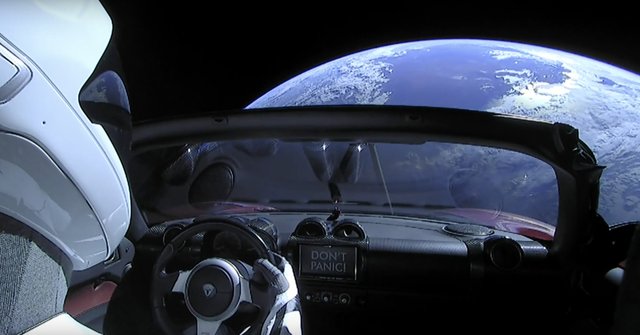Elon Musk’s Tesla overshot Mars’ orbit, but it won’t reach the asteroid belt as claimed
Elon Musk’s Tesla Roadster, which launched on top of SpaceX’s Falcon Heavy on Tuesday, is going farther out into the Solar System than originally planned. The car was supposed to be put on a path around the Sun that would take the vehicle out to the distance of Mars’ orbit. But the rocket carrying the car seems to have overshot that trajectory and has put the Tesla in an orbit that extends beyond the Red Planet’s path. However, the Tesla won’t be making it to the asteroid belt, as SpaceX CEO Elon Musk originally claimed.
After launch, the Tesla cruised through space for a good six hours — a trip that was also live-streamed by SpaceX. This “coast” phase was meant to show off a special orbital maneuver for the US Air Force before the rocket completed one final engine burn in space and put the car on its final orbit. It looks like that burn might have happened somewhere over Southern California, as some people in the area started reporting sightings of the rocket igniting in the night sky after 9:30PM ET on Tuesday.
Third burn successful. Exceeded Mars orbit and kept going to the Asteroid Belt. pic.twitter.com/bKhRN73WHF — Elon Musk (@elonmusk) February 7, 2018
Now it seems that engine ignition worked a little too well. Musk originally tweeted out a map on Tuesday of what was thought to be the Roadster’s final orbit after the burn, showing just how far out the car would travel. And it looked like the Tesla would go out into the asteroid belt, getting relatively close to the orbit of the dwarf planet Ceres.
But astronomers online noticed some discrepancies with the numbers Musk tweeted, and SpaceX ultimately sent a revised orbit to NASA’s Jet Propulsion Laboratory on Wednesday (You can find it by selecting “target body” -143205.) The new orbit shows that the car will indeed travel farther out than the orbit of Mars, but not far enough to make it to the asteroid belt. The belt begins about 329 million miles from the Sun, and the Tesla will reach a distance about 160 million miles away from the Solar System’s star.
Before the Tesla launched, Musk said that there was an extremely tiny chance that the vehicle would ever hit Mars, and that seems to hold true. Within the next decade, the Roadster will make its closest approach to Mars in October of 2020, coming within 4.3 million miles, according to Jonathan McDowell, an astrophysicist at Harvard and spaceflight expert. He also figured out the next time the Roadster gets “close” to Earth is in March of 2021, when it passes within 28 million miles of our planet.
Summary: Starman will be lonely for a long time to come — Jonathan McDowell (@planet4589) February 8, 2018
The Tesla’s journey certainly demonstrates the Falcon Heavy’s capabilities of putting objects into deep space. The idea that the rocket could send things to the asteroid belt is likely to be attractive to some space companies, like Planetary Resources and Deep Space Industries, which are working on technologies to mine water from asteroids someday. But even though the Roadster won’t be venturing into the belt, it will still overshoot the orbit of Mars, which is good news for scientists looking to send vehicles to the Red Planet some day.
Update February 8th, 5:20AM ET: This article has been updated to include a revised orbit for the Tesla given to NASA, which shows the car won’t make it to the asteroid belt.